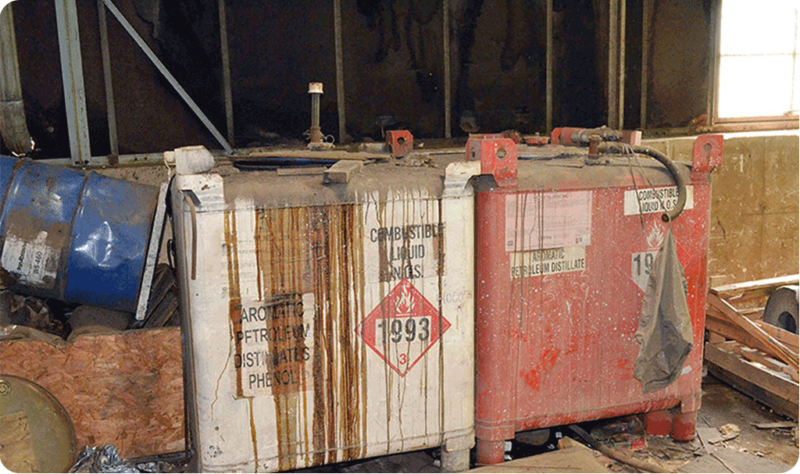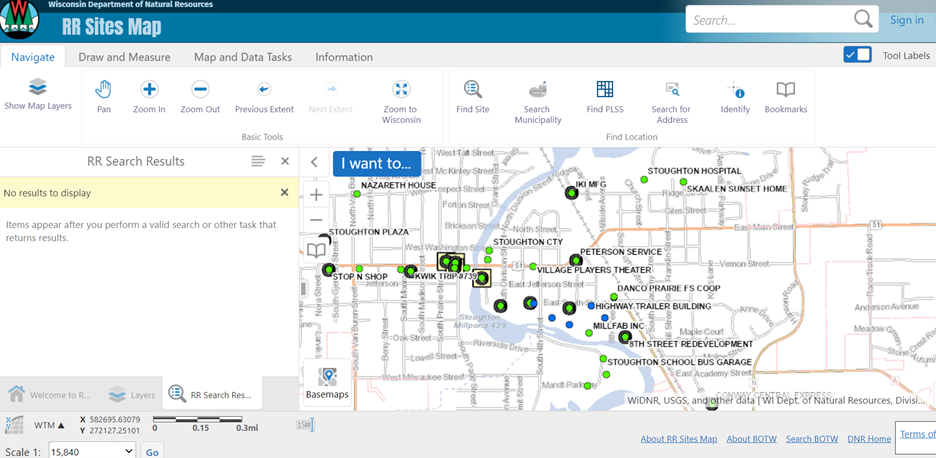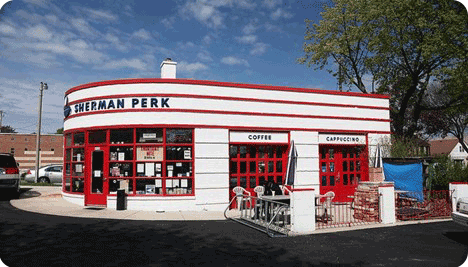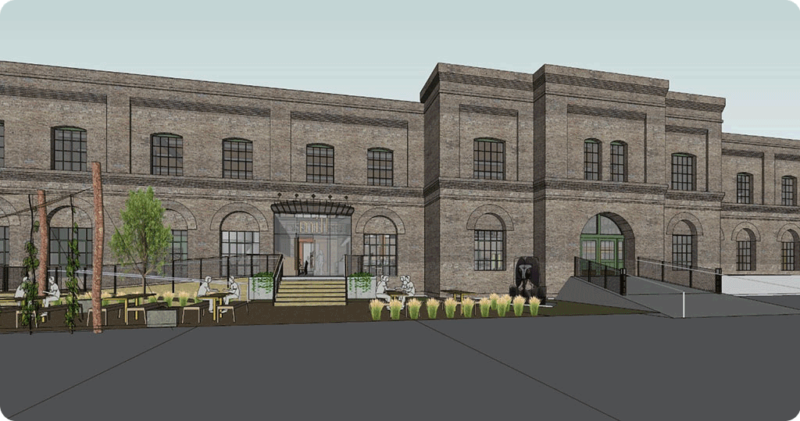
Sometimes contaminants are left behind at commercial properties.
A typical Wisconsin community has many productive commercial and industrial sites that are valuable assets. Those businesses provide needed jobs and income to the residents and the tax base necessary to fund local services that raise the quality of life and help upgrade community infrastructure. Over time, these properties are bought and sold, used and reused, without complications.
Unfortunately, not every commercial or industrial site will remain productive or even valuable. Some properties remain idle and undesirable due to the visual condition of the property. They are eyesores and have dilapidated buildings, poorly kept grounds and trash.
But it may be what can’t be seen that makes the property undesirable. Depending on what these sites were formerly used for, contaminants such as petroleum, metals, asbestos, pesticides, PCBs and solvents could be found.
When real or perceived environmental contamination concerns exist that discourage additional investment, the community has a brownfield. Generally, brownfields consist of current or former industrial, manufacturing or recycling sites that are vacant and underutilized. However, they can also include current or former gas stations or dry-cleaning establishments located in downtowns and residential neighborhoods.
Redeveloping these sites is often difficult due to the unknown environmental condition and, just as importantly, the unknown costs required to address the potential issue. The buyer sees both an asset and a liability, and smart buyers will naturally seek safer investments in alternate sites or greenfield development when possible. As a result, private redevelopment of a brownfield may not occur unless technical and financial public efforts are made to identify, quantify and clean up the environmental problems at these sites.
Wisconsin’s innovative approach to brownfields
Wisconsin was one of the first states to adopt brownfield reforms with the Land Recycling Law in 1994. Over time, the state has built a well-deserved reputation for having innovative approaches and policies allowing communities to ensure their brownfields are attractive to developers and ready for redevelopment.
Additionally, there are numerous investigation and cleanup funding sources available along with additional avenues to obtain liability assurances, which help curb redevelopment costs and reduce contamination liability.
In general, the person who “causes,” “possesses” or “controls” the contamination, such as someone who owns property with a contaminant discharge or owns a container that has ruptured, is responsible for cleaning up the property. Wisconsin statutes, however, provide certain liability exemptions for local government units, lenders and others who follow appropriate procedures. For example, obtaining property through foreclosure, tax foreclosure or blight elimination may exempt some municipalities and lenders from the environmental liability that an outright property purchase would not.
Anyone may obtain a fee-based liability clarification letter from the Wisconsin Department of Natural Resources (DNR). These letters can then help property owners, potential purchasers, neighbors, tenants and others complete real estate, business or financial transactions with written environmental liability clarifications from the DNR.
In addition to liability protections, the DNR has developed and implemented a flexible closure process on contaminated sites that places less emphasis on active removal of contaminants and more emphasis on addressing source control, surface soil contamination and pathways to groundwater.
This allows residual contamination to remain on site with little health and safety risk. However, it may require the property owner to maintain the property according to a state-approved plan to assure contact with residual contamination is minimized—for example, maintaining asphalt or other approved cover over contaminated areas.
The property and maintenance plan is listed on the DNR mapping and tracking systems, a web-based mapping system providing information about contaminated properties and other activities related to investigation and cleanup of contaminated soil or groundwater in Wisconsin.
This tool can help local officials, community development groups, real estate agents, bankers and others seeking to identify and address properties with the most challenges.

This DNR mapping and tracking systems tool can help local officials, community development groups, real estate agents, bankers and others seeking to identify and address properties with the most challenges.
A primer on brownfield assessment and cleanup
Brownfield redevelopment does require the expertise of an environmental professional to assist in addressing site contamination under the state’s Spills Law (Wis. Stat. §292). As a result, an environmental consultant is usually hired to assist local governments, developers and owners through a process of assessment, investigation, cleanup and site closure. Typically, the consultant will produce a report at each stage detailing the results, including:
- Phase I environmental assessment: The phase I assessment identifies current or historic operations suspected of having used hazardous substances or petroleum products during on-site operations. Some common uses of concern are dry cleaners, gas stations, auto and vehicle repair, printing operations and manufacturing. Areas of concern may be identified that should be further investigated, such as storage tanks, drainpipes and other problems.
- Phase II environmental assessment: The phase II report is produced after testing areas of concern through soil and groundwater testing. Tests will screen for common chemical and other substances and the report will identify if results exceed regulatory standards. When contamination is discovered above standards, there is a legal obligation to notify the DNR.
- Site investigation report/remedial action plan: Contamination may be discovered in one or more areas of the property and the site investigation report will evaluate the degree and extent of the problems, as well as the potential of the contamination to impact the environment, such as water wells, bodies of water or vapor migration. Remedial action planning will outline options to address the contamination, such as soil removal, capping, or vapor-mitigation venting.
- Site closure reports: When cleanup has occurred, a case closure request will be submitted to the DNR for official closure. But in cases in which some residual contamination remains on site, the DNR may establish continuing obligations required of the property owner. For example, the property owner may need to maintain pavement over a certain area of contamination or need DNR approval to place wells on the property.
When possible, be sure to involve your environmental consultant in the planning process. Knowing site use, such as residential versus industrial reuse, or site-specific improvements to be made, like underground parking or utilities, may significantly affect the type and extent of any cleanup effort.

Renovated gas station now serves up coffee and cappuccino.
State programs boost brownfield redevelopment
Unsurprisingly, the cost of addressing site challenges often creates a financing gap that can be difficult to overcome by traditional means; when that happens, local governments and developers need additional assistance.
WEDC administers several grant programs to assist in the redevelopment of brownfields, including the Brownfield Site Assessment Grant, Brownfields Grant and Idle Sites Redevelopment Grant. These programs provide assistance for municipalities to position the properties for successful development, remove blight and revitalize the area.
Brownfield Site Assessment Grants
These grants can provide up to $150,000 to perform the initial environmental investigations of former commercial or industrial properties, along with other activities such as demolition and associated asbestos abatement, as well as underground and above-ground storage tank removals.
By identifying and quantifying the environmental problems of a property, the municipality and/or development partners may be able to develop a cleanup strategy that allows the property to be developed.
The grant applicant must be the municipality or an associated entity such as a Community Development Authority or Redevelopment Authority, but the property may be publicly or privately owned. A local match investment of 20% of project costs must be provided with either public or private funds.
Brownfields Grants
When environmental contamination is documented at a former commercial or industrial site, WEDC offers a Brownfields Grant of up to $250,000.
These grant funds, which may be provided to local units of government, businesses and individuals, may typically be used for further environmental investigation, remediation or monitoring of the site. In addition, the grant may be used to remove hazardous waste containers, demolish buildings that are truly deteriorated beyond repair and install vapor mitigation systems.
Idle Sites Redevelopment Grants
WEDC also administers this grant program that may be used for larger industrial, commercial and institutional properties, but that may or may not have identified contamination.
The Idle Sites Redevelopment Program offers grant of up to $250,000 to municipalities to address the challenges of redeveloping larger sites with outdated buildings, infrastructure or site conditions.
Approved projects can use funds for building renovation, environmental remediation, infrastructure, demolition of unsalvageable structures, or site-specific improvements to advance the site to shovel-ready status or enhance the site’s market attractiveness.
Eligible sites must be idle or underutilized for at least two years and must be four acres in size. Properties from former institutional sites may be considered if they are less than four acres and located within a commercial corridor. For former commercial sites, properties must be within Economically Distressed Communities or Opportunity Zones, where the acreage limit is reduced to two acres.
DNR assistance programs
The DNR also offers brownfield assistance. The DNR’s Remediation and Redevelopment Program, which oversees the investigation and cleanup of contaminated properties, also offers financial assistance to municipalities for these efforts.
The Wisconsin Assessment Monies program is available as a contractor services awards cover Phase I and Phase II environmental site assessments, with potential for limited site investigation work at selected sites.
Sites in this program should generally be less than 10 acres in size and have petroleum or hazardous substance contamination which can be assessed for less than $35,000; no local match is required. This program is often used in conjunction with WEDC’s Brownfield Site Assessment Grant program and will often cover the 20% match requirement.
Wisconsin DNR’s Ready For Reuse Program offers grant and loans to local governments and nonprofits to help clean up environmental contamination at brownfields.
The program, funded by U.S. Environmental Protection Agency grants to the DNR, provides grants of up to $200,000 when the applicant is the owner of the property. Otherwise, if not owned, the local government or nonprofit may apply for zero-percent loans for projects requiring at least $250,000 in environmental cleanup.
A local tool: Environmental TIF
Many Wisconsin communities use Tax Incremental Financing (TIF) Districts to publicly fund projects to raise the tax base of a defined area or district. Not as many have taken advantage of the ability to create an Environmental Remediation TID.
Environmental Tax Incremental Financing (ERTIF) may be created to specifically address brownfield and environmental expenses. The districts differ from other tax incremental financing districts in that they are not included in the traditional limit based on equalized values (12%); in addition, unlike other TIFs, the base value of an ERTIF may be $0.
Renovated commercial and industrial sites provide needed jobs and income to the residents and the tax base necessary to fund local services.

Renovated commercial and industrial sites provide needed jobs and income to the residents and the tax base necessary to fund local services.
Brownfield redevelopment equals community development
Brownfields tend to go hand in hand with economic decline of an area. Idle and unused property represents the lost incomes and jobs. Beyond that, the property is now likely to contribute to blight, higher crime, vagrancy and/or vacancy rates, which can lead to declining property values and reduction of the local government tax base. All of this contributes to a deteriorating quality of life for residents in brownfield areas and represents lost opportunities for reinvestment.
Redeveloping these sites can be challenging. Cooperation is needed among government, the regulatory agency, the development community, financial institutions, nonprofits and neighborhood organizations.
While challenging, brownfield redevelopment can bring exponential benefits above the elimination of health hazards. Successful redevelopment creates a vitality to older centers and neighborhoods that will be a catalyst for further investment, new jobs and increased property values.
Communities may experience many environmental, social and economic benefits from brownfield redevelopment by removing health hazards, removing blight through renovating abandoned buildings and removal of derelict structures, and preserving historical landmarks.
All of this can increase property values and create a healthy urban landscape. Brownfield redevelopment promotes sustainability, especially when existing buildings are cleaned up, renovated and reused.
Help is available
WEDC and the Wisconsin DNR can jointly meet with local government officials, property owners, developers and financial institutions to discuss property conditions, potential steps to take and financial resources available to help properties get redeveloped.
These “green team” meetings can be coordinated by either agency, but individuals are welcome to reach out to a WEDC regional economic development director to schedule a meeting.
